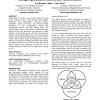Free Online Productivity Tools
i2Speak
i2Symbol
i2OCR
iTex2Img
iWeb2Print
iWeb2Shot
i2Type
iPdf2Split
iPdf2Merge
i2Bopomofo
i2Arabic
i2Style
i2Image
i2PDF
iLatex2Rtf
Sci2ools
CHI
2005
ACM
2005
ACM
Designing systems that direct human action
In this paper we present a user-centered design process for Active Capture systems. These systems bring together techniques from human-human direction practice, multimedia signal processing, and human-computer interaction to form computational systems that automatically analyze and direct human action. The interdependence between the design of multimedia signal parsers and the user interaction script presents a unique challenge in the design process. We have developed an iterative user-centered design process for Active Capture systems that incorporates bodystorming, wizard-of-oz user studies, iterative parser design, and traditional user studies, based on our experience designing a portrait camera system that works with the user to record her name and take her picture. Based on our experiences, we lay out a set of recommendations for future tools to support such a design process. Author Keywords Direction, recognition, error, mediation, active capture, error-prone systems, multimedia...
Active Capture Systems | CHI 2005 | Human Computer Interaction | Multimedia Systems Design | User-centered Design Process |
Related Content
| Added | 30 Nov 2009 |
| Updated | 30 Nov 2009 |
| Type | Conference |
| Year | 2005 |
| Where | CHI |
| Authors | Ana Ramírez Chang, Marc Davis |
Comments (0)

